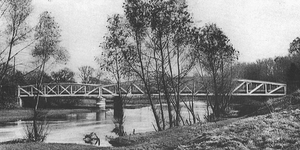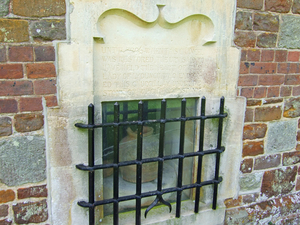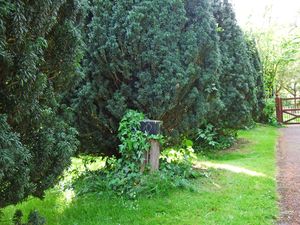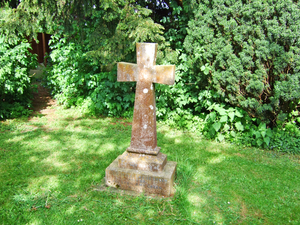History
Beginnings

West Parley is much older than our neighbours Bournemouth and Ferndown, and has deeper roots than most of the settlements in South East Dorset. West Parley figures in the Domesday Book (1086) when it had some 60 inhabitants. At that time it had a Saxon Church, replaced by the present All Saints Church in the 12th century.
A series of informative Heritage articles on the history of West Parley.
More on West Parleys history and details of the heritage walk.
In fact West Parley goes back much further, all the way to the Iron Age. Dudsbury Rings, to the South West of West Parley, is the remains of an Iron Age hill fort; its walls (which can still be seen) protecting a great defensive site on a high bluff overlooking the River Stour.
The village in medieval times was of course agricultural. It was owned by a succession of Lords of the Manor, none of whom lived in the Parish. In the 1600s - see map - Parley Common was divided into peculiarly long and narrow strips. The reason was that a principal product was turf for fuel.
With some areas being wetter and poorer than others, the strips gave everyone a fair share. One of them was nearly 2 miles long and only 22 yards wide. Parley Common has now become heathland, home to many wild birds and animals, and is protected as a Site of Special Scientific Interest (SSSI)
Also of great interest is a 1900-01 Ordnance Survey map of West Parley.
Please also see this 1928 book about West Parley by Charles Drew.


New Bridge
In the 1800s the extraction of gravel and clay became important locally, used to put on tracks to make them passable, and to make bricks for houses locally and in Bournemouth. A map of 1888 shows a large brick field and kiln in the centre of East Parley Common. The only principal roads at that time were what we now know as Christchurch Road, the B3073, and Church Lane - although the beginnings of Parley Cross could be seen.



The New Road bridge (first image) dates from 1910 - before that West Parley was a quiet backwater, cut off from the rapidly growing Bournemouth. The build up of West Parley starts from that time, growing to its present size (1560 houses) in the house building boom after World War Two.
The so-called "Ferndown Road Bridge'" (middle image), which crossed the River Stour in New Road, West Parley. It was built in 1910 but collapsed a few years later and was replaced in 1923 by the present New Road Bridge.
West Parley now has the status of a parish, with its own Council. In the 19th century the parish of West Parley used to be much larger, including Longham and West Moors.
All Saints Church
The bottom of Church Lane gives a feel for West Parley in the 1700s. From the 1780 cottage at Brambles Farm the road winds down to the old heart of West Parley, by the river.
The Old Rectory and Church Farm House flank a characterful small area, a sort of square, leading up to the small church and further along to the river path. In Spring with the cherry trees out it is a beautiful spot and you can stand there in a time capsule taking you back hundreds of years.



Famous author Arthur Mee writes:
"Where a shady track leads to the ferry
a small Church with a timber belfry
stands among the corn fields. Almost
every generation has made it some good
gift. The walls are Norman, with stones
from Saxon England still left in them, and
the man who carved the arches round the
old font lived either in Saxon days or very
soon after the Conquest. The doorway
was made when Domesday Book was
new, and while Edward 1st was hammering
the Scots, men were quarrying sandstone
for the chancel arch. When Chaucer
was writing his Canterbury Tales, some
sturdy smith was forging the strap-hinges
for the Church door, while a wood carver
was busy on the delicately ornamented
bosses of the 14th century roof, which
are now in a glass case in the vestry. One
shows the Boy Scouts' reef knot. In the
days when Englishmen were fighting
against Joan of Arc someone hewed a new
top and set it on the old font. When the
Reformation came and Shaftesbury Abbey
was dissolved an armchair from the abbey
found its way to West Parley. Its chalice
was engraved by a master silversmith in
Shakespeare's day. Its pulpit was made
at the time when England and Scotland
were first united and is still as sound as
ever after 300 years; and when all the
country was astir with news of the French
Revolution Thomas Pyke cast for West
Parley a bell decorated with cherubs."
All Saints is a small 12th century Church perfectly in tune with its surroundings, set in a well kept churchyard housing many of our agricultural forebears. Inside it has distinctive wooden walled pews, some of them with their own doors.
Outside, on the East wall, set into a barred recess, is an urn said to contain the heart of the Lady of Lydlinch. Once the Lady of the Manor at West Parley in the 1300s, she was made by her husband to live at Lydlinch, near Sherborne. She said that as her heart was in West Parley she wished it to go there after her death.
In the Churchyard just to the right of the gate is a wooden stump with a sundial on top. This wood is from the gibbet at West Parley, formerly on the common, near what is now the top of Barrack Road. On it was hanged and gibbeted the son of one William Harbin, convicted at Winchester in 1803 of murdering his father, persuaded to do so by his mother fearful that William was about to change his will. The owner of the land housing the gallows was tired of all the sightseers and so gave the wood to the then rector, who mounted the sun dial on top. It is said that because of its dreadful background it never tells the right time.

Also in the Churchyard to the left of the gate is a cross in memory of another tragedy, the death of Elise and Sybil Green, sisters aged 22 and 16, drowned in the river Stour on the 24th Jan 1908. They had crossed the river on Marshall's Ferry, but after stepping on to the bank they sadly walked on but took a wrong turn, ending up in the river and being taken by the currents. At that time the ferry, at a ford near the church, was a longboat with the ferryman pulling on a rope fixed above the river. There were tea gardens on the bank for ferry users from 1903.
Please also see the full story of the Green sisters tragedy